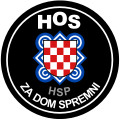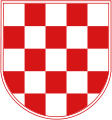- Croatian Defence Forces
-
Croatian Defence Forces
Hrvatske obrambene snage
Flag of the Croatian Defence ForcesActive 22 January 1991–16 April 1993 Country  Croatia
Croatia
 Bosnia and Herzegovina
Bosnia and HerzegovinaBranch Army Size 24,000[1] Headquarters Zagreb, Croatia
Ljubuški, Bosnia and Herzegovina
Zenica, Bosnia and HerzegovinaNickname Blacks (Crnci) Motto Za dom spremni Colors Black March HOS - Za dom spremni Engagements Battle of the Barracks
Battle of Vukovar
Siege of Dubrovnik
Siege of SarajevoDisbanded September 1991 in Croatia[2]
August 21, 1992 in Bosnia and Herzegovina[3]Commanders Notable
commandersDobroslav Paraga
Blaž KraljevićThe Croatian Defence Forces (Croatian: Hrvatske obrambene snage, HOS) was the military arm of the Croatian Party of Rights (HSP) from 1991 to 1992 during the first stages of the Yugoslav wars.
During the Croatian War of Independence, the HOS organized several early companies and actively participated in the Croatian defence. At the peak of the war in Croatia the HOS had grown to several battalions in size. The first HOS units in Croatia were headed by one Ante Paradžik, a prominent member of the HSP. He was, however, killed by Croatian police officers in September 1991. After the November 1991 general mobilisation in Croatia, and the January 1992 cease-fire, HOS was gradually absorbed by the Croatian Army.
The HOS units in Bosnia and Herzegovina consisted of Croats, Bosniaks and foreign volunteers led by Blaž Kraljević.[4] On August 9, 1992, Kraljević and eight of his staff were assassinated by Croatian Defence Council (HVO) soldiers under the command of Mladen Naletilić.[5] The HOS was shortly afterwards disbanded and absorbed into the HVO and Army of the Republic of Bosnia and Herzegovina at the beginning of the Croat-Bosniak War.[4] The last HOS unit was dissolved on April 5, 1993 in central Bosnia.[6]
Contents
Name
The frequently used Croatian abbreviation of the organization, "HOS" (Hrvatske obrambene snage), is identical to the abbreviation for the military of the World War II Nazi puppet state, the Independent State of Croatia. The military of the Independent State of Croatia were the Croatian Armed Forces (Hrvatske oružane snage), also abbreviated "HOS" in Croatian.
History
Croatia
Foundation
Croatian Party of Rights was reestablished in Croatia on 26 February 1990, and Dobroslav Paraga becomed it's first president. Ante Paradžik was named vice-president. Since Serbs of Croatia had becomed revolted, Croatian civil population started to arm it self. On 21 December 1990 Serbs started revolt and soon Yugoslav People's Army combines with revolted Serbs. Croatian Party of Rights starts to consider formation of their own military wing.
Even though first squad of HOS was founded in January 1991, officialy, HOS was founded on 25 June 1991 by Dobroslav Paraga, Ante Paradžik, Alija Šiljak and other leaders of HSP. Soon after they founded General Staff of HOS and Paradžik was named it's chief. General Staff of HOS was in HSP's headquarters in Zagreb called Starčević's Center. At first, HOS was poorly armed, HOS soldiers procure weapons them selfs. However they becomed prominent in conflits with Serb forces so they attracted the attention of Croatian public. Soon HSP got donations from Croat diaspora and branches of HSP in Australia and Canada so they had abbility to buy more weapons and soon membership in HOS inceresed. However, not every member of HSP supporet the idea of founding party's military wing, Krešimir Pavelić, party's secretary opposed, so as I sign of protest he left the party.
Soon many recruits of HOS came from diaspora, Bosnia and Herzegovina and overseas. Also HOS had many foreign volunteers, professional soldiers were leaving their homelands and trained HOS soldiers.
Battles
At the beginning of the Croatian War of Independence, HOS had number of 6,000 soldiers. They were partly depending of Croatian National Guard (ZNG), but they obeyed orders only from HOS officers. Because of unwriten rule that HOS members can be only members of HSP, HOS was considered a party paramilitary organization. At first, HOS, along with ZNG, was involved in Battle of the Barracks and other minor battles in whole Croatia. HOS incresed popularity of HSP. Soon, HOS was founded in almost every town were HSP was active. On 10 September 1991, Paraga and Paradžik organized a demonstration of one HOS company before 10,000 people on Jelačić Square. Immediately after demonstration, this company was sent to Battle of Vukovar under command of Robert Šilić.
At the same time, HOS units were founding in Dalmatia. Until May 1991, HOS units of Dalmatia were in size of a company. By an agreement between Paraga and Slovene minister of defence Janez Janša, these units were sent to Slovenia for special training. Until October 1991 this unit grown to battalion, and it was named 9th Battalion Rafael "The Knight" Boban, and it's commander becomed Jozo Radanović, a president of HSP's branch in Split. This unit becomed one of the most popular Croatian units. At the beginning of December 1991 Radanović was promoted to rank of colonel of HOS.
Paradžik was gunned down at a police checkpoint near Zagreb on September 21, 1991, in what was described by the authorities as an accident.
On November 23, 1991, the Croatian Government started a general mobilization, and most of the militiamen of HOS joined the ranks of the regular Croatian Army units. Not long after the final cease-fire of January 1992, HOS was no longer active in Croatia.
Bosnia and Herzegovina
Blaž Kraljević was a Croat paramilitary leader during the first few months of the Bosnian War who commanded the HOS. When the war began Kraljević began to position the HOS as the main Croat militia in Bosnia and Herzegovina. Unlike the other Croat militia, the HVO, the HOS opposed the division of Bosnia and Herzegovina and the creation of an ethnically cleansed Greater Croatia, instead he wanted to ally Bosnia and Herzegovina with Croatia.[7]
After many early successes a large number of HVO soldiers defected and joined the HOS.[8] In the summer of 1992 the HOS successfully defended Stolac, and launched an offensive into eastern Herzegovina which seized parts of the municipality of Trebinje. Much of the Serb population of Trebinje and Bileća had begun to pack up run. This went against the Graz agreement that Serbia and Croatia made regarding the division of the country.
After Blaž Kraljević was killed, HOS in Bosnia and Herzegovina was led by Ante Prkačin and Stanko Primorac.
Symbols
The HOS used a black flag with the emblem in the middle, with a circle of triple-wattle within which is a chequy shield (with white first square) over a four-sided blue-white triple wattle symbol, above the inscription HOS, below HSP, Za dom spremni.[9]
Units
Name Symbol Headquarters Commander 1st Battalion Ivan "The Knight" Brdar
(1. bojna Ivan Vitez Brdar)
Livno, Bosnia and Herzegovina Mate Šukan 2nd Battalion Stojan Vujnović "The Serb"
(2. bojna Stojan Vujnović Srbin)
Domaljevac, Bosnia and Herzegovina Stojan Vujnović 4th Battalion of HOS
(4. bojna HOS-a)6th Battalion Marijan Baotić
(6. bojna Marijan Baotić)Vinkovci, Croatia 9th Battalion Rafael "The Knight" Boban
(9. bojna Rafael vitez Boban)
Split, Croatia Marko Skejo 1st Company Ante Paradžik
(1. satnija Ante Paradžik)Jasenovac, Croatia Vukovar HOS Company
(Vukovarska satnija HOS-a)Vukovar, Croatia Robert Šilić 13th Battalion Jure "The Knight" Francetić
(13. bojna Jure vitez Francetić)
Tomislavgrad, Bosnia and Herzegovina Ivan Mamić The Knights
(Vitezovi)
Vitez, Bosnia and Herzegovina 101st Battalion To Drina
(101. bojna Do Drine)Sarajevo, Bosnia and Herzegovina 19th Battalion "The Knight" Jure Francetić
(19. bojna Vitez Jure Francetić)Gospić, Croatia Valentin Rajković Black Wolfs
(Crni vukovi)Kalesija, Bosnia and Herzegovina Marked Ones
(Žigosani)
Novi Travnik, Bosnia and Herzegovina The Hunters Company
(Satnija Lovci)
Ljubuški, Bosnia and Herzegovina Autonomous Company of Security
(Samostalna satnija osiguranja)Zagreb, Croatia Mostar HOS Battalion
(Mostarska bojna HOS-a)Mostar, Bosnia and Herzegovina Ljubuški Company of HOS
(Ljubuška satnija HOS-a)Ljubuški, Bosnia and Herzegovina Zenica Company of HOS
(Zenička satnija HOS-a)Zenica, Bosnia and Herzegovina Tuzla Company of HOS
(Tuzlanska satnija HOS-a)Tuzla, Bosnia and Herzegovina Čapljina Company of HOS
(Čapljinska satnija HOS-a)Čapljina, Bosnia and Herzegovina Gallery
-
Blaž Kraljević, the commander of HOS in Herzegovina.
-
The Croatian Coat of Arms used by the soldiers of HOS.
-
The patch of HOS-a from Prozor-Rama
-
The HOS patch used by some HOS soldiers in Bosnia and Herzegovina
See also
References
- ^ "Politička ubojstva: Nedavno uhićenje Ivana Andabaka u žižu vraća ubojstvo Blaža Kraljevića, generala HOS-a, borca za BiH do Drine. I organizatori I ubojice na slobodi" (in Bosnian). Jutarnje novine. 2000-12-01. http://www.hsp1861.hr/vijesti/201201jnbjo.htm. Retrieved 2011-04-25.
- ^ Absorbed into the Croatian ground army
- ^ Absorbed into the Croatian Defence Council and Army of the Republic of Bosnia and Herzegovina
- ^ a b Nigel Thomas, Nigel Thomas (2006). The Yugoslav Wars: Bosnia, Kosovo and Macedonia 1992-2001. Osprey Publishing. p. 21. ISBN 1841769649.
- ^ Ramet, Sabrina P. (2006). The Three Yugoslavias: State-Building and Legitimation, 1918-2004. Indiana University Press. p. 343. ISBN 0271016299.
- ^ Shrader, Charles R. (2003). The Muslim-Croat Civil War in Central Bosnia: A Military History, 1992-1994. Texas A&M University Press. p. 46. ISBN 1585442615.
- ^ "IT-98-34-T, the Prosecutor versus Naletilic and Martinovic". ICTY. 17 July 2002. http://www.icty.org/x/cases/naletilic/trans/en/020717ED.htm. Retrieved 2007-09-25. "Q. Well, sir, during the time that you lived in Mostar, during these years, and in that region, did you ever -- did you understand that HOS was a unit that -- an organisation that believed more in a multi-ethnic Bosnia of the Croats and Muslims working together? ... wasn't it because of the HDZ's conflict with that philosophy, that Mr. Kraljevic was ultimately murdered?"
- ^ Pg 85 - "From Ottawa to Sarajevo: Canadian Peacekeepers in the Balkans" (PDF). Centre for International Relations, Queen's University Kingston, Ontario Canada. 1998. http://www.queensu.ca/cir/files/Martello18.pdf. Retrieved 2007-09-25.ISBN 0889117888
- ^ "HOS, Croatian Defence Forces". crwflags. 2008. http://www.crwflags.com/fotw/flags/ba%7Dhsp.html#hos. Retrieved 2008-03-11. "The HOS used a black flag with the emblem in the middle, with a circle of triple-wattle within which is a chequy shield (with white first square) over a four-sided blue-white triple wattle (similar to the one used as Ustasha symbol, on flags of the Independent State of Croatia in World War II), above the inscription HOS, below HSP, ZA DOM SPREMNI (For Homeland. Ready!)."
Categories:- Military units and formations of the Croatian War of Independence
- Military units and formations of the Bosnian War
- Anti-communist organizations
Wikimedia Foundation. 2010.















